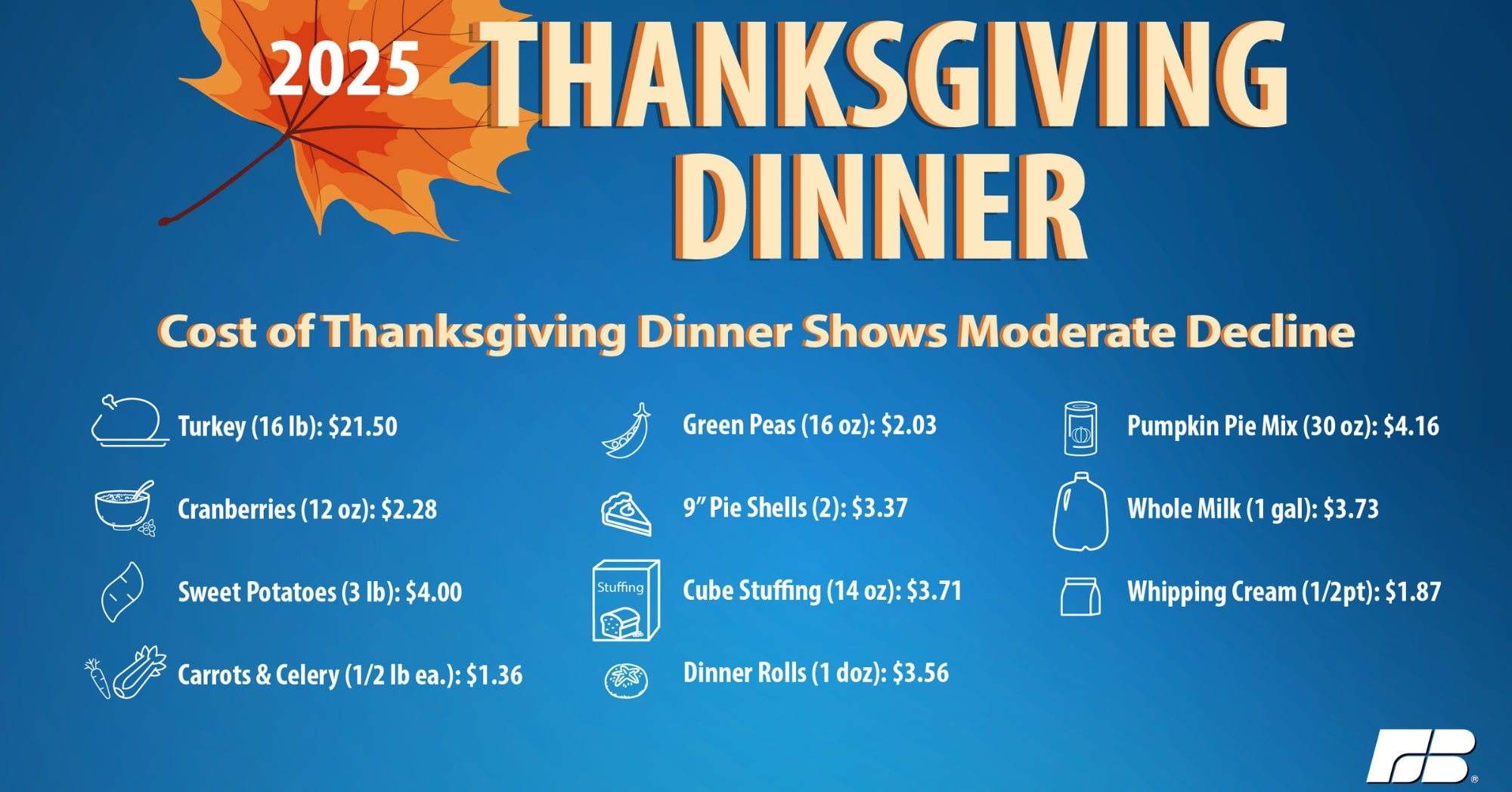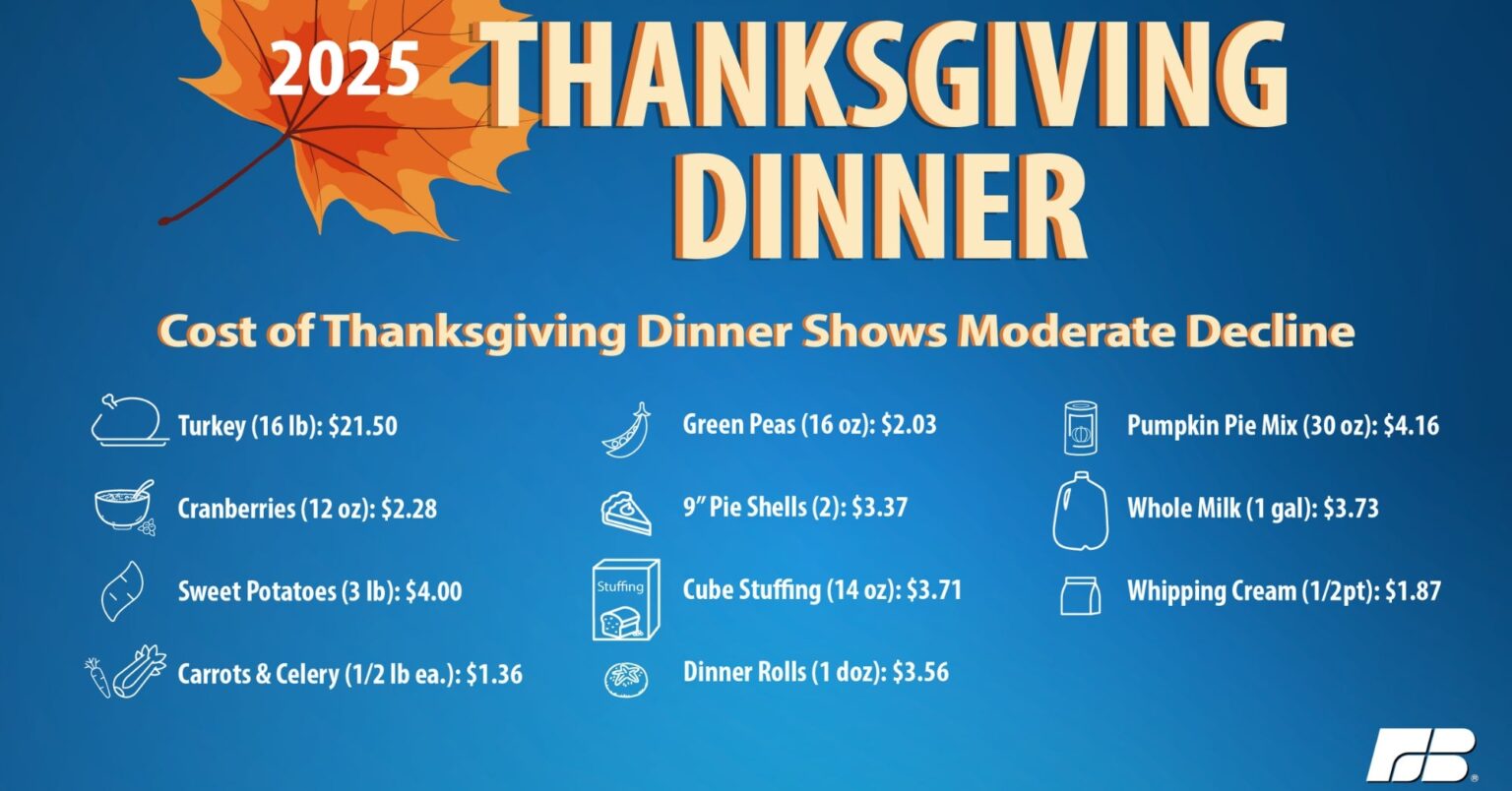The American Farm Bureau Federation’s annual Thanksgiving dinner survey shows that a classic holiday meal for 10 will cost $55.18, a 5 percent decrease from last year (though still above prices from four years ago). While consumers may appreciate the modest savings, several items on the menu also reflect the mounting financial pressures facing America’s farmers and ranchers.
Each year, volunteer shoppers across all 50 states and Puerto Rico track the cost of common Thanksgiving staples. Since 1986, the survey has captured the prices of turkey, cubed stuffing, sweet potatoes, dinner rolls, frozen peas, fresh cranberries, celery, carrots, pumpkin pie mix and crusts, whipping cream, and whole milk.
The basket isn’t intended to reflect every family’s exact recipe lineup, but it reliably measures price trends across many classic dishes.
This year’s results show a mixed picture: turkey, stuffing, cranberries, and dinner rolls all declined in price, while sweet potatoes, frozen peas, vegetable trays, whole milk, and whipping cream all climbed. Pumpkin pie mix and shells stayed nearly flat year-over-year.

When factoring in items added to the survey in 2018: ham, Russet potatoes, and frozen green beans, the total rises to $77.09, or $7.71 per person.
Historically, turkey has driven nearly half of the total dinner cost. But this year, a 16-pound bird represents only 39 percent of the meal’s total price, its smallest share since 2000.
A combination of cheaper frozen turkeys and pricier side dishes is behind the shift. A 16-pound turkey now averages $21.50, down 16 percent from last year. Fresh turkey prices continue rising due to ongoing highly pathogenic avian influenza impacts, but frozen birds have become more affordable.
Meanwhile, declining year-round demand has also affected turkey markets, with per-capita consumption falling to 13 pounds per year, down nearly 3 pounds from six years ago.
Despite the cheaper turkey, side dishes are eating up a greater share of the Thanksgiving budget. Rising production costs, including fertilizer, fuel, machinery, labor, and land, continue to strain fruit, vegetable, and potato growers.
Sweet potatoes and fresh vegetable trays represent two of the survey’s largest price spikes. Sweet potatoes are up 37 percent, driven in part by hurricane-related losses in North Carolina, which grows more than half the nation’s supply. Vegetable trays surged more than 61 percent, a reminder of how vulnerable fresh-produce pricing is to weather, labor shortages, transportation disruptions and regional production setbacks.
“High labor costs and worker shortages are a major driver of produce costs,” writes AFBF. Even small increases in per-unit costs can create large year-over-year percentage jumps for items that traditionally start from a low baseline.
Still, not all sides rose in price. Dinner rolls fell 14.6 percent, stuffing dipped 9 percent, and cranberries slid 2.8 percent, helping offset costlier produce.
Regional differences persist
Depending on where you live, Thanksgiving dinner could cost significantly more or less than the national average. The West leads with the highest regional price for the classic meal at $61.75, followed by the Northeast at $60.82. The South remains the most affordable at $50.01, with the Midwest close behind at $54.38.
These differences hold when including ham, potatoes and green beans. The South again is lowest at $71.20, while the Northeast hits $82.97 and the West tops out at $84.97.
While shoppers may see a slight reprieve this season, farmers continue facing intense economic pressure. “Farmers and ranchers are struggling,” writes AFBF. “Crop prices have fallen again while fuel, fertilizer, labor and machinery costs continue to climb, leaving many operations below breakeven.”
Weather disasters, from drought to flooding to hurricane damage, have cut yields and strained finances further. Export slowdowns have added to the uncertainty.
Producers continue absorbing much of the food system’s risk to keep store shelves stocked, often without seeing the consumer cost declines reflected in their own bottom lines.


